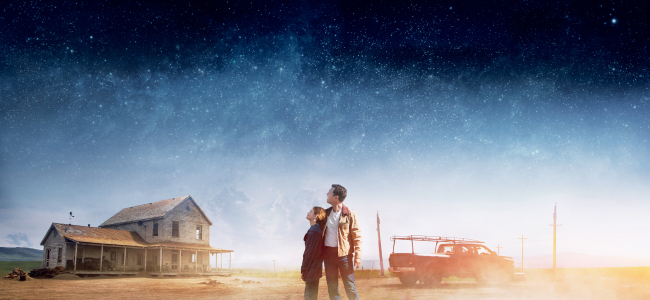Since his breakthrough with the backward-running “Memento,” Christopher Nolan has made a plaything of time. In “Interstellar,” he slips into its very fabric, shaping its flows and exploding its particles. It’s an absurd endeavor. And it’s one of the most sublime movies of the decade.
As our chief large-canvas illusionist, Nolan’s kaleidoscope puzzles have often dazzled more than they have moved, prizing brilliant, hocus-pocus architecture over emotional interiors. But a celestial warmth shines through “Interstellar,” which is, at heart, a father-daughter tale grandly spun across a cosmic tapestry.
There is turbulence along the way. “Interstellar” is overly explanatory about its physics, its dialogue can be clunky and you may want to send composer Hans Zimmer’s relentless organ into deep space. But if you take these for blips rather than black holes, the majesty of “Interstellar” is something to behold.
The film opens in the near future where a new kind of Dust Bowl, one called “the blight,” brings crop-killing storms of dust upon the Midwest farm of engineer-turned-farmer Cooper (Matthew McConaughey) and his two children, the adventuresome 10-year-old Murph (Mackenzie Foy) and the 15-year-old budding farmer Tom (Timothee Chalamet). The rustic homestead, where Cooper and his father-in-law (John Lithgow) drink beer on the porch, recalls the Indiana home of “Close Encounters of the Third Kind” ― an early hint that “Interstellar” ― moving and sentimental ― will be more Spielberg (who was once attached to direct) than Kubrick.
In the imperiled climate, space exploration is viewed as part of the “excess” of the 20th century. Textbooks now read that the moon landings were faked. But Cooper, a former NASA pilot, still believes in science’s capacity for greatness. He seethes: “We used to look up in the sky and wonder about our place in the stars. Now we just look down and wonder about our place in the dirt.”
The spirit of wonderment, too, has sometimes lacked in our movies. Nolan ― who shot in both 35mm and 70mm and prefers his films massive on Imax, but not, thank our stars, in 3-D ― remains one of the few purveyors of DeMille-sized big-screen grandeur.
 |
Matthew McConaughey (left) and Mackenzie Foy in a scene from “Interstellar.” (Warner Bros. Korea) |
Nolan shoots for the stars, literally and cinematically, when Cooper’s curiosity (he and Murph tail a flying drone through the wheat fields) brings him to a secret NASA lair run by a Dr. Brand (Michael Caine). Large-scale dreaming has gone underground. They enlist him to pilot a desperate mission through a wormhole to follow an earlier expedition that may have found planets capable of hosting human life.
Much discussion of gravity and relativity follows, as Nolan (who cowrote the script with his brother Jonathan and consulted with theoretical physicist Kip Thorne) tries valiantly to place his quasi-plausible sci-fi tale within the realm of mathematics and science. “Interstellar” is a trip, for sure, but it’s not a supernatural one. There will be no aliens poking forth from bellies or monument-blasting battles with extraterrestrials; it’s just about us humans.
The journey means Cooper will, under the best of circumstances, be gone for years. The parting from Murph, who resents the abandonment, is wrenching. He’s a dutiful, driven father stepping out to work, only in another galaxy. All they can send him are video messages.
His crew are Brand’s daughter (Anne Hathaway), a pair of researchers (a wonderful David Gyasi and Wes Bentley) and a robot named TARS that looks like the monolith of “2001: A Space Odyssey” if it were a shape-shifting Transformer. Voiced by Bill Irwin, it’s programed to speak with 90 percent honesty and a dash of humor.
What happens when the space ship, Endurance, moves past Saturn and passes through the wormhole? For starters, Nolan and his cinematographer, Hoyte Van Hoytema, conjure beautiful galactic imagery, contorting space and, eventually, dimensions.
But what he’s really doing is dropping countless big ideas ― science, survival, exploration, love ― into a cosmic blender, and seeing what keeps its meaning out there in the heavenly abyss. As in “The Dark Knight,” Nolan doesn’t investigate all of its philosophical questions so much as juggle them in an often dazzling, occasionally frustratingly incomplete way.
But under extreme gravitational forces, the core of “Interstellar” holds. It remains tethered to Earth, toggling between barren, otherworldly landscapes and life back home on an increasingly uninhabitable planet. There, Murph (now played by Jessica Chastain) has grown into a physicist trying to solve an essential equation.
More than anything, “Interstellar” makes you feel the great preciousness of time, a resource as valuable as oxygen. A misadventure of a few hours on one watery planet, where relative time accelerates, costs the astronauts decades. Returning to the ship, Cooper watches videos of his kids growing up before his eyes and weeps uncontrollably.
All of the visual awe, the quantum mathematics, the seeming complexity of the hugely ambitious, nearly three hour-long film is just stardust clouding the orbit between a dad and his girl. Whereas most science fiction withers out in space, “Interstellar” rockets home.
“Interstellar,” a Paramount Pictures release, is rated PG-13 by the Motion Picture Association of America for “some intense perilous action and brief strong language.” Running time: 165 minutes. Three and a half stars out of four.
By Jake Coyle
(The Associated Press )




![[Herald Interview] 'Trump will use tariffs as first line of defense for American manufacturing'](http://res.heraldm.com/phpwas/restmb_idxmake.php?idx=644&simg=/content/image/2024/11/26/20241126050017_0.jpg)

![[Health and care] Getting cancer young: Why cancer isn’t just an older person’s battle](http://res.heraldm.com/phpwas/restmb_idxmake.php?idx=644&simg=/content/image/2024/11/26/20241126050043_0.jpg)

